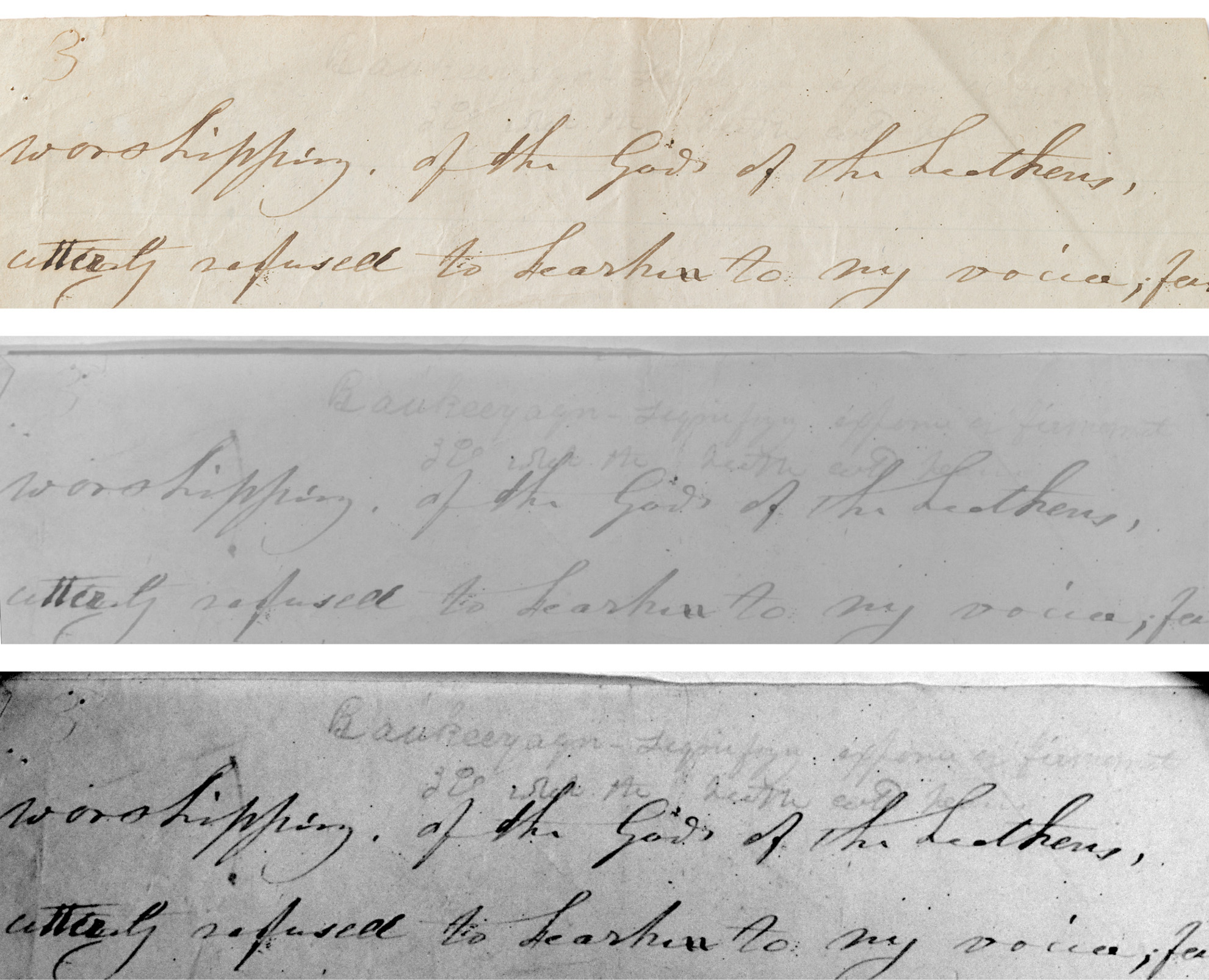Note on Photographic Facsimiles, Book of Abraham and Related Manuscripts
No matter the care put into transcribing a text, a gap
still remains between the reader and the physical document. The use
of photographic facsimiles in this volume narrows that gap but does
not eliminate it. This note explains how these photographs were
created and prepared for publication and identifies some of their
limitations.
Creating the Photographs
The textual photographs herein were created specifically
for this publication and its online counterpart by Welden C.
Andersen and, in the case of the images of the printed version of
the Book of Abraham, members of the preservation staff at the Church
History Library. Andersen used a Hasselblad H3DII-39 multishot
camera equipped with a Hasselblad HC 120mm f4 macro lens. By taking
a sequence of four photographs, this camera captures red, green, and
blue data for every pixel, whereas a single-shot camera records only
one color per pixel. The four-shot technology therefore captures
much more detail. The lens is optimized for extremely close
focusing, allowing for images of documents that can resolve to the
level of individual fibers of the paper. Each of the digital images
produced by the camera comprises approximately 229 megabytes of
information. Though the resolution of these images must be reduced
significantly for print publication, the Joseph Smith Papers Project
retains the original, full-resolution files, which will allow
researchers to view extremely detailed electronic images. Indeed, a
primary purpose for creating these photographs was to minimize the
need for researchers to consult the original documents.
During photography, the manuscripts were positioned on a
low, leveled table. Studio lights diffused by a fabric screen were
used to illuminate the subject, and a computer was attached to the
camera to process and store the images. The camera was positioned
about four feet above the table on a camera stand. Andersen
hand-focused each photograph and then remotely triggered the
shutter. After ensuring the quality of the first image on the
computer monitor, he made a second exposure to create a security
backup copy for each image.
Andersen followed standard professional procedures to
achieve the highest accuracy in color, tone, contrast, and exposure.
Before photographing and any time he adjusted lighting, exposure, or
document angle, he calibrated and corrected color using a color test
card and color adjustment software. This eliminated any bias of the
camera sensor and the light source, meaning that the colors captured
in the photographs are as close as possible to the colors of the
documents as they exist today.
Preparing the Photographs for Print
Publication
Charles M. Baird, a prepress specialist with the
Publishing Services Department of The Church of Jesus Christ of
Latter-day Saints, prepared the images for printing. Following
standard prepress methods, Baird reduced the images to fit the page
size in this volume at a
resolution of approximately 300 dpi and converted the images from
the color format stored by the camera (red, green, and blue) to the
colors used in printing (cyan, magenta, yellow, and black).
As mentioned earlier in this note, the documents featured
in this volume were photographed resting on a table. For aesthetic
reasons, Baird used photo-editing software to digitally remove the
table from the background and to add a thin shadow around the edge
of each image.
Except as described in this note, the textual photographs
in this volume have not been altered.
Limitations of the
Photographs
Even careful photographs can underplay important features
of the original document. Four categories of such features are worth
noting here.
First, the documents in this volume are of many different
sizes, though the image sizes used herein to maximize readability in
the available space may give the illusion that the documents are
roughly the same size. Readers should carefully consult the physical
description of each document to determine its size.
Second, some documents featured in this volume include
unconventional writing patterns that require special treatment. The
Egyptian Alphabet documents, for example, are written on large
sheets of paper, some of which were folded in half to resemble a
book. On a few pages, writers wrote all the way across the sheet, so
that a single line spans both the left and right pages. In an effort
to represent the record as it actually appears and to preserve the
detail of individual words, such sheets are artificially divided in
half and presented in this volume on two successive spreads—the
first containing the top half of the sheet and its transcription,
and the second containing the bottom half and its transcription.
Third, some nontextual features of the manuscripts are
represented in the photographs but not commented on in the
transcription or annotation. For instance, some pages show
bleed-through or ink transfer from adjoining pages, but these marks
are not noted.
Fourth, some documents herein contain multiple blank
pages, which are not reproduced in this volume. Readers wishing to
consult the blank pages of these manuscripts can view them in their
entirety at josephsmithpapers.org.
Techniques Used to Recover Canceled
Text
Transcribers for this volume used multispectral imaging
and photo-editing software to recover obscure text or study
characteristics of the manuscripts. Multispectral imaging, which
uses different wavelengths of light to show features that cannot be
seen by the human eye, revealed text on one of the Nauvoo-era Book of
Abraham manuscripts that was otherwise unreadable. (See
fig. 1.) Similarly, the two concentric circles etched into a page of
Notebook of Copied Egyptian Characters, circa Early July
1835, are difficult to see in an ordinary digital image.
Photo-editing software allowed the page to be enhanced so that the
circles could be more closely
examined.

Fig. 1. A faint graphite
inscription at the top of a page of one of the Nauvoo-era manuscripts of the Book of Abraham is nearly invisible to
the naked eye (top). Multispectral imaging made the inscription less
obscure (middle), and the use of photo-editing software allowed
editors to read and transcribe it
(bottom).